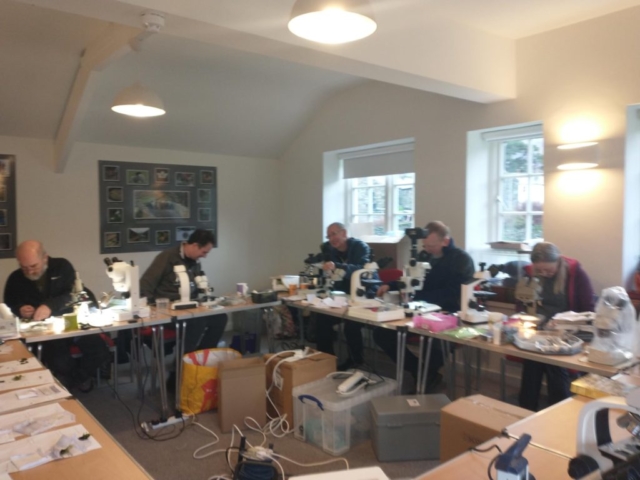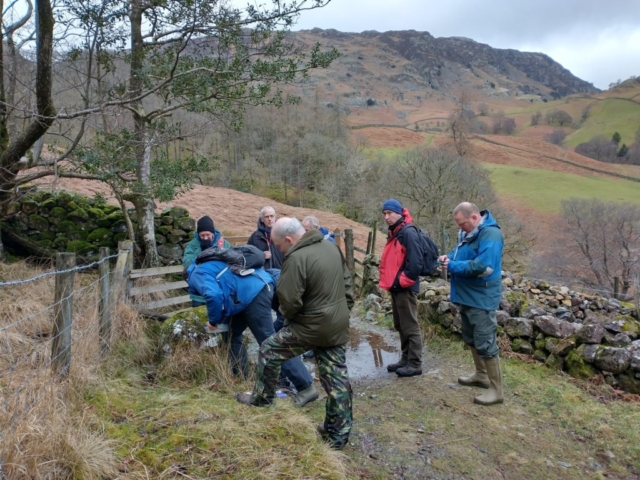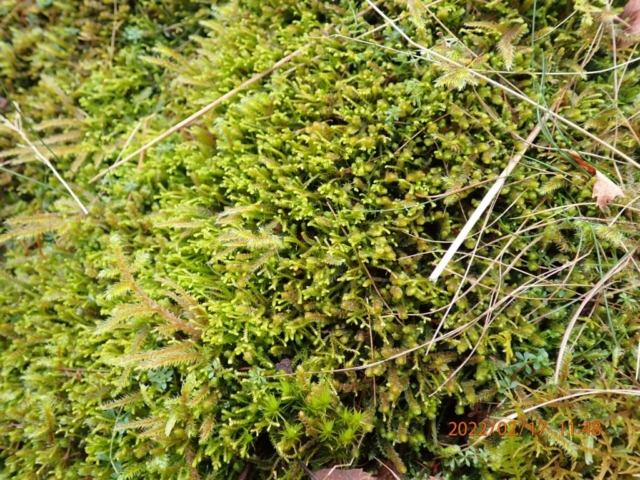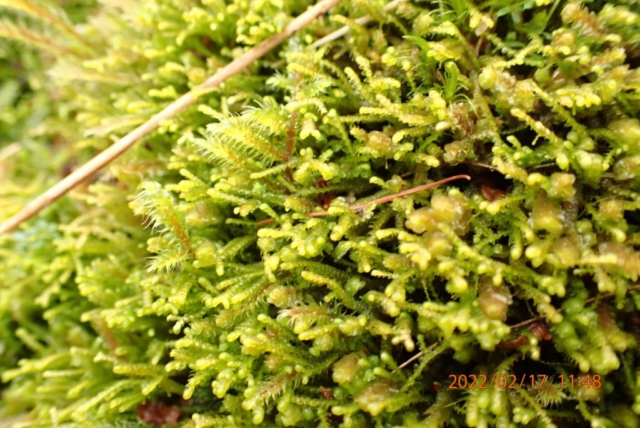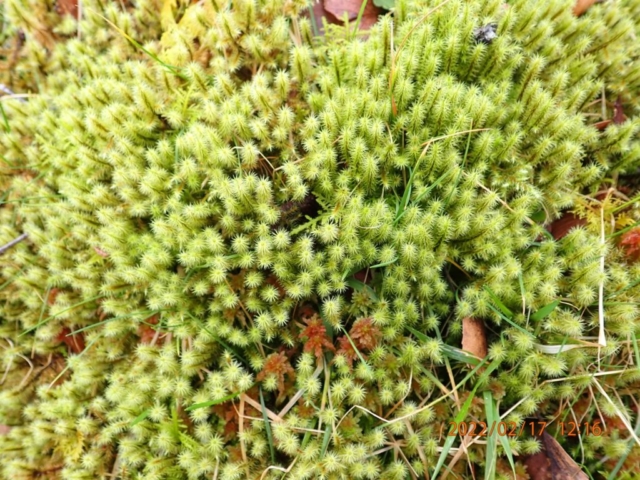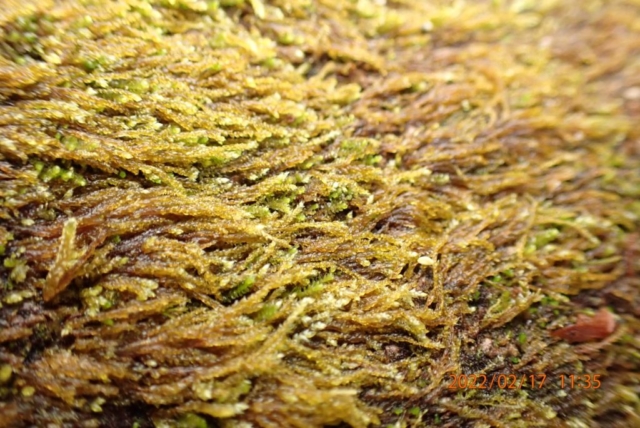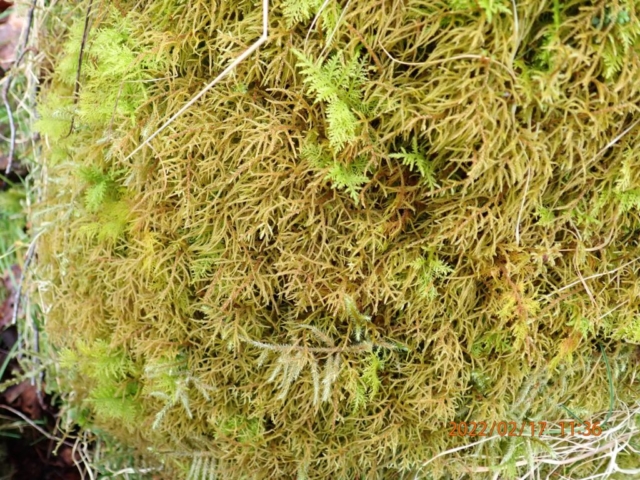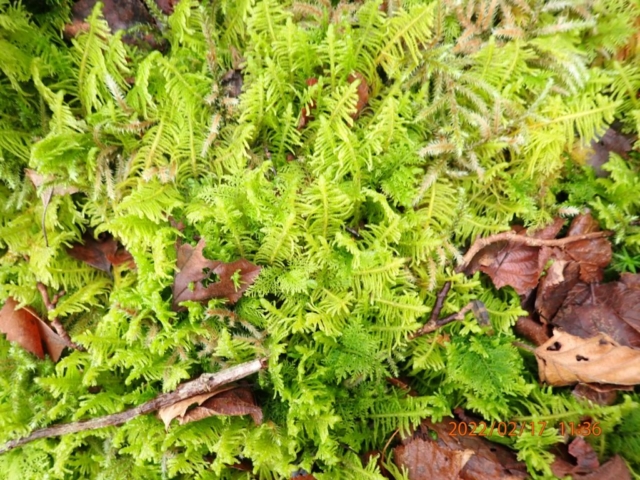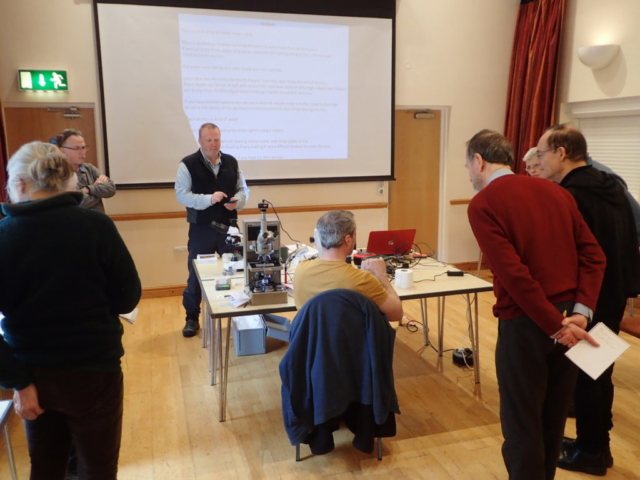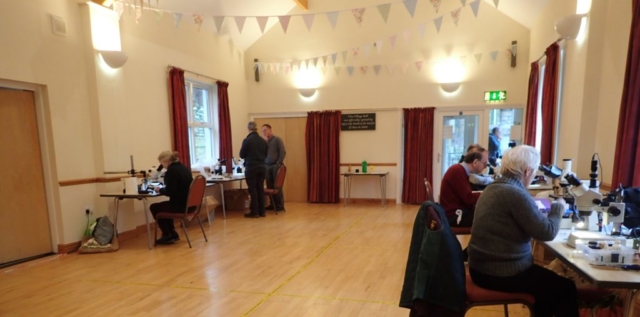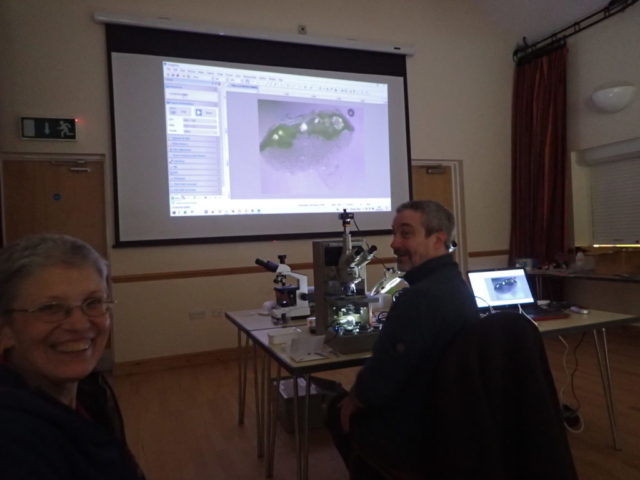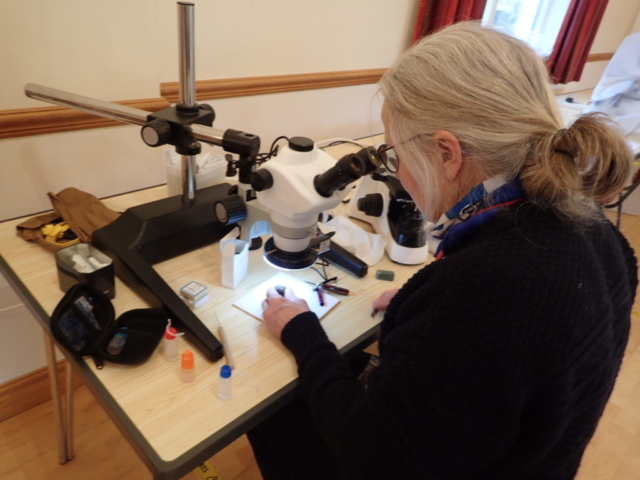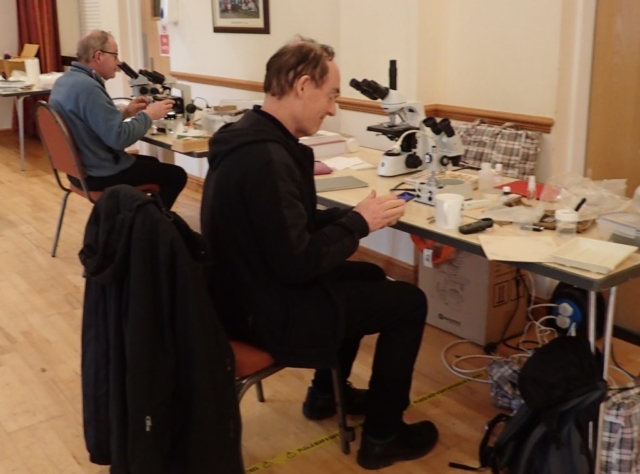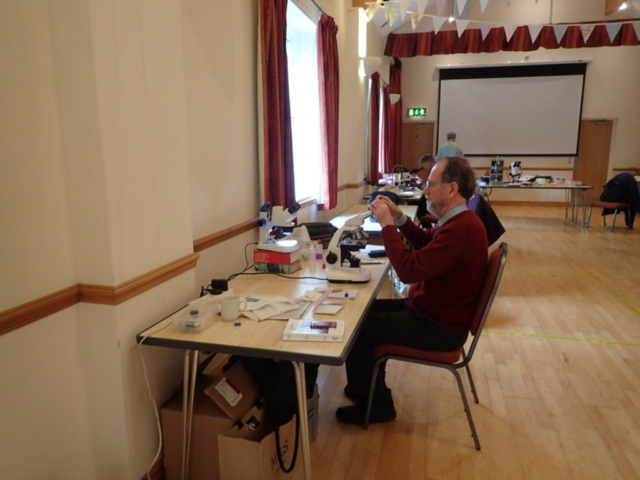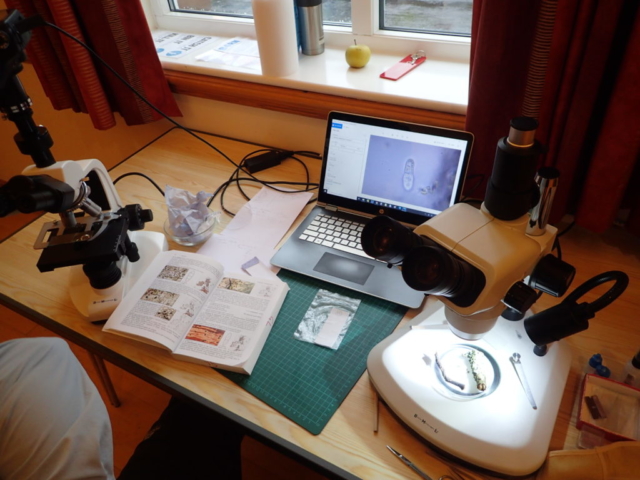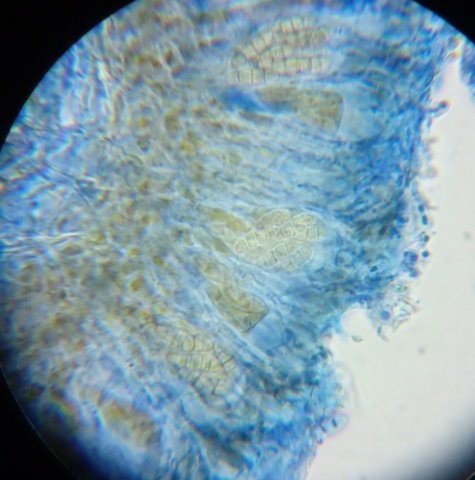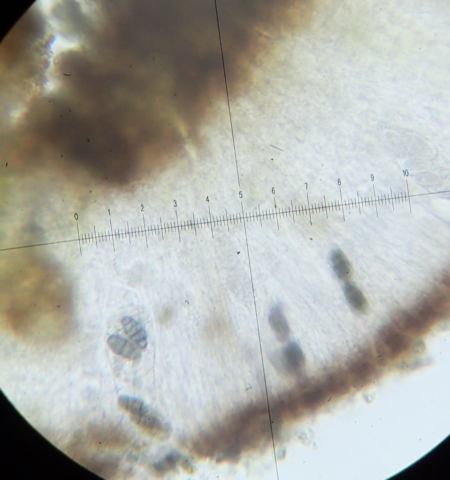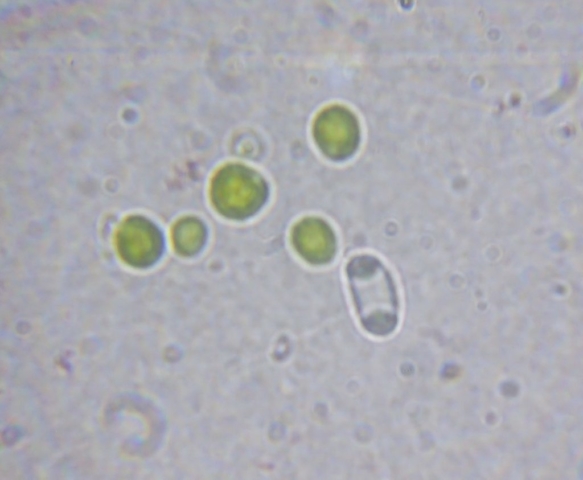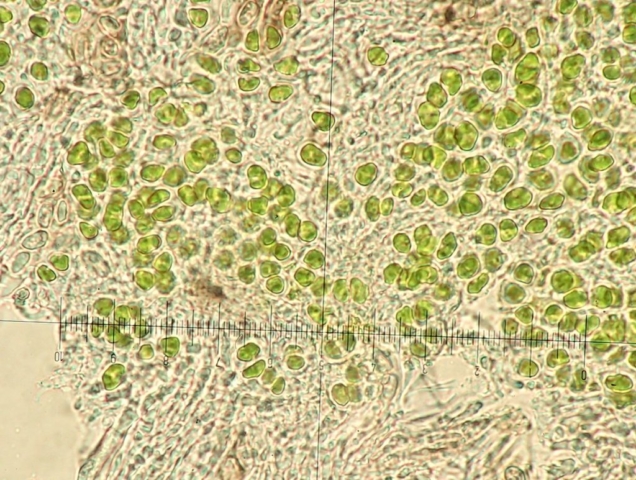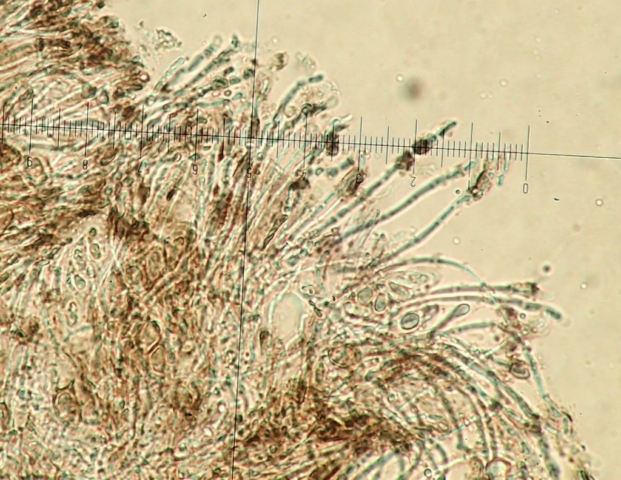Thanks to funding from Natural England and extra funding support from the British Lichen Society, we were able to run two-day training sessions in February 2022 for both bryologists and lichenologists. The funding also included the purchase of microscopes which will be held by Cumbria Biodiversity Data Centre available for loans; we expect to have these available at our forthcoming indoor id sessions. The funding also includes the purchase of textbooks and equipment sundries, also available to group members.
Bryophyte training
On Wednesday 16th February, nine people interested in furthering their bryological identification skills via microscopy met at the Borrowdale Institute, Rosthwaite. Two aspects of the venue were ideal: firstly, its immediate proximity to some outstanding bryophyte assemblages in the local area (the “Atlantic temperate rainforest”, which thankfully is receiving more publicity in recent times via the work of Plantlife, Natural England and other bodies), and secondly, the splendidly refurbished Herdwick Suite itself, which was bright, well-appointed and spot on. It is important to thank David Freeman (of Natural England) for his work in organising the training, and also Natural England itself, for funding the activity.
The training’s linchpin was Nick Hodgetts, who was our expert instructor. He, (I have to say), wore his extraordinary depth of knowledge and identification skills lightly, along with an affable and enthusiastic demeanour, throughout the two-day event: he helped in equal measure the least experienced of us, and the most, judging expertly how to support each person’s efforts. Here’s how the training unfolded……
0900hrs, arrivals. David (and Clare Shaw, who deserves all our thanks for her admin and bryological support) had already prepped the room with suitable tables, chairs and electrical supply. We each brought our own ‘scopes (stereo and compound and associated kit). There was additional kit comprising good-quality (brand new!) ‘scopes, slides, pipettes, and other paraphernalia, via the generous support of Natural England and CBDC. Nick had brought in addition, a reference arsenal of bryology textbooks laid out to the front, which we all enjoyed perusing (and using for ID information).
0930hrs, introductions and planning. We decided, as a group, to use the first few hours on a field visit to Johnny’s Wood, a 10-minute walk away, to collect samples for ID. Clare had prepped some of her own grid references for interesting species, so we made our way to an area with Hageniella micans, Herbertus aduncus, Bazzania tricrenata… all three of which (and many, many more species) were located and enjoyed. Nick pointed out species as they appeared, and took “requests” also. A recurring theme of the field visits was that if anyone mentioned they were keeping an eye out for a target species, Nick would then nonchalantly find it in minutes, explain the key ID features, and move off to help another group member. We knew heavy rain was on its way, and it duly arrived.
1200hrs, squelched back to the Institute, de-kitted wet clothes, and got stuck into microscopy-aided ID of various specimens. Nick and Clare helpfully laid out some named examples at the front, plus some ID challenges for us. A few hours passed in the blink of an eye.
1430hrs, Nick demonstrated and explained practical sectioning of leaves, then we all practised. More ID work enjoyably followed. Then, Nick led us in a guided talk-through of how to use a key based on leaf morphology (from Watson 2nd Ed) to accurately ID an unknown target sample – I think the whole group enjoyed and benefited from this action (which was repeated with other samples later). The rest of the afternoon’s session was individual ID work, supported by Nick and with a good measure of cooperative self-help between people also. Session closed around 1630hrs for some (needing to travel home) and nearer 1730hrs+ for those of us staying locally.
0930hrs Thursday 17th February (day 2), a repeat of day 1. This time better weather. David selected a different part of the Johnny’s Wood site for us to visit, with the primary target species being Anastrepta orcadensis. A 20 minute walk-in saw us at the bottom of a gentle N-facing wooded slope…. which as we made our slow way up it, turned into a steeper, wooded boulder field, containing one of the most delightful and luxurious bryophyte-filled habitats I’ve ever seen. David found us the Anastrepta, and Nick continued to find us a rich variety of interesting species. And, to be fair, each of us worked on our own IDs, too. For example, Jim noted several species he then called the group’s attention to, as did Clare and Peter. For example, the group discussed (and saw) various Frullanias, including F fragilifolia (found) and F teneriffae (which we thought we may have found, but subsequent microscopical work proved that we hadn’t – a perfect example of why microscopy is invaluable in bryology ID.) We did see Scapania umbrosa, Lepidozia pearsonii, Thuidium spp, some Sphagna including subnitens, and others.
1300hrs back to the Institute. The whole afternoon, more ‘scope work, more sectioning, and another interesting exemplar use of a key. Nick also agreed to support ID of various specimens some of us had brought along. The weather was, however, deteriorating and snow was forecast to come in. Hence, we all agreed that discretion would be the better option, and the training closed down around 1530hrs for some, and not much later for all. A spirited (and rapid) group effort saw the kit disassembled and packed up, tables wiped, stacked and the room made ready for departure.
In summary, I feel all participants developed their skills and their confident enjoyment of microscopical work with bryophytes. The whole atmosphere was warm, purposeful and relaxed; a good place to finish is to once more thank Nick Hodgetts for all his work, thank Natural England for the grant, and to note that all of us will be looking forwards to the next CLBG bryo event.
Gary Lawrence
Photos from Clare Shaw
Lichen Training
To identify some lichens to species you need to look at the thallus, fruit and pycnidia under microscopes, typically doing sections using a razor blade at low magnification under a “dissecting microscope”, then using a “compound microscope” to look at the microscopic details at higher magnification – more info.
Two days of microscope training from John Douglass aimed to ensure everyone could do the basics, moving on to cover more advanced techniques that are helpful.
The course was held in Mungrisdale Village hall, where the facilities were excellent. The 10 attendees each had a table for themselves, giving plenty of space for microscopes and other equipment. These were well spaced out, which contributed to an atmosphere where concentration was needed to practise what was being taught.
The sessions covered:
- Squashes, sections and spores. Including identifying and measuring the different layers, dealing with pycnidia, applying K & C under cover slips & oil immersion
- Identifying ascus tips & staining, including use of ink/vinegar and Lugol’s Iodine to stain the medulla.
- Use of polarising filters to see crystals.
- Identifying photobionts – algae and cyanobacteria
In spite of having read about these aspects it was really helpful to see the techniques demonstrated and have dedicated time to try them out. There is no short cut to making thin sections other than practise and a sharp razor blade. John Douglass was on hand to show us various refinements to the techniques such as the amounts of chemicals to use, how to apply them and how to transfer sections of apothecia. It takes endless patience which he certainly has. John and others brought previously identified specimens for participants to practise on which helpfully gave known outcomes.
The meeting provided a much needed opportunity to obtain polarising filters, chemicals and dropper bottles. These events take a lot of organising, much of which is “unseen” and so thanks to John, Caz and Chris plus the funders who enabled this to happen.
These sessions gave people confidence to have a go at microscopy in a supportive atmosphere and to realise that it is do-able.
Some comments from attendees:
- “I was so glad I managed to get to the microscope training. It’s something I’ve wanted to do for a couple of years now.”
- “A very big thank you to everyone who helped to arrange and deliver the microscope training this week.
“What did I learn? First, that microscope work on lichens is doable. It’s fiddly, and it may go wrong, but you just have to get stuck in and try again. And second, everyone struggles at times; it isn’t just me.
“But when it works, it opens up a whole new world, and I begin to see how it will make a big difference. I might even be able to follow Dobson’s main key now!” - “For the last couple of years I have been trying to pluck up courage to buy microscopes. As a complete technophobe could I even cope with setting them up? Then this workshop appeared and it was the push I needed.
“The workshop was a fantastic help. A refresher on some things, some new ideas and great support from everyone. It was really helpful to see other people’s work and get a better grip on what we were looking at. John’s PowerPoint presentations were very clear and he was incredibly helpful.
“My find of the day turned out not to be a lichen at all!” - “Very informative and inspiring! Many thanks.”
- “A week on from the event, I’m fired up to try out sectioning and staining lichens. I’m really looking forward to any follow ups.”
- “I’d be keen to attend the saxicolous crust training when it happens- I’m keen to start learning these, so I will look out for emails.”

